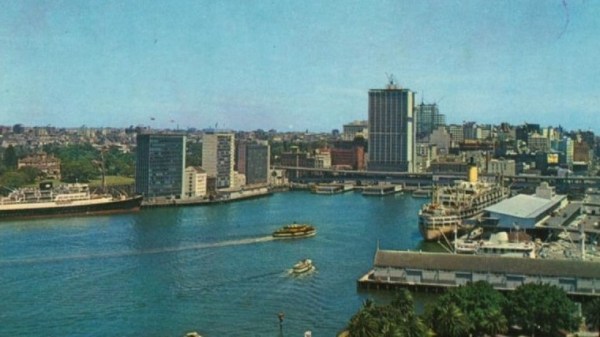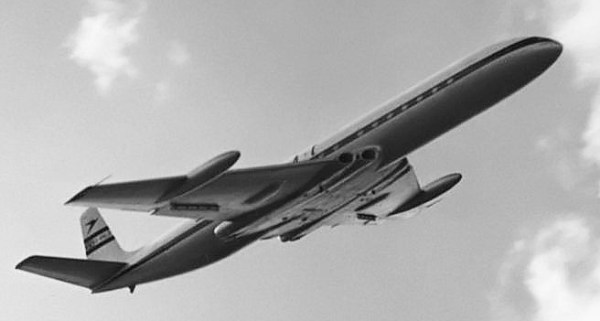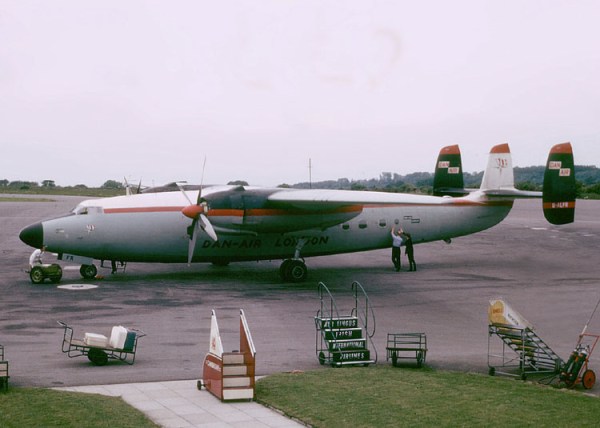
The Oronsay, at Circular Quay, found here
As part of our 15th birthday celebrations, we’ve trawled through the archives to bring you some of the best, weirdest and most salacious articles published on Crikey since our launch on February 14, 2000.
*This article was originally published on November 30, 2010.
When I became a reporter, on this day in 1960, the great ocean liners still sailed regularly to Europe and North America, and it was possible to take a ship between most of the capital cities.
But not for much longer.
Some afternoons, when Sydney and Mary and Susanna, Malcolm, Jean, baby Fiona and I then lived in working-class Clovelly, there would be three jets in a row after school, a Qantas 707-138, a longer fuselage Pan American 707, and a BOAC Comet IV.

The Comet III that failed to win Qantas away from the 707. Wikipedia Commons
The arrival of the jet age was as much a visible, and insistent signal of change as television and satellites.
The jets were a homework disrupting event. We’d rush outside to watch. The ear-splitting noise of a Super Constellation grinding its way into the air was an event that would unpack a practice scrum, or completely silence a classroom.
And then, one day after the leaving certificate exams, it was time to go to work, to Broadway with a letter from the editor of The Sydney Morning Herald, Bill Fitter, advising me to turn up at 2pm in the teleprinter room, next to the subeditors’ room, on the fifth floor.
My job was that of a copy boy. But to lift my pay above 5 pounds/11/6d to more than 6 pound required taking the Saturday police rounds radio monitoring shift for the Sun-Herald, and, since I wore a suit and looked like a young reporter, I wrote stories. Little stories. Filler stories. No one noticed.
Until one Saturday night. The inmates at the Parramatta Girls’ Home set fire to the roof and threw burning mattresses onto the police below, and the usual police roundsman being otherwise engaged, I called up a photographer and a radio car and wrote a big story, for page 1 with a spill on page 3. This was noticed by “Granny”.
How this quickly led to being paid as a cadet reporter rather than fired is for another time. I soon became the shipping cadet, and by historical accident, The Sydney Morning Herald’s last full-time shipping cadet, as the jets brought the age of the great ocean passenger liners into deep decline , with fewer celebrities to be interviewed as their ships (which you joined off the Customs launch from 7 Circular Quay) made their leisurely way to Walsh Bay or Woolloomooloo.
Having lived on Goat Island in Sydney Harbour for part of small boyhood (in the cottage furthest from the harbour master’s mansion), when my father, a marine engineer, decided to take a land-based position with the Maritime Services Board, and having being taken to sea with him at other times, shipping had become a part of my daily life.
This was a Sydney that read the shipping column with as much attention as it read Column 8 (which I also later edited for about a year), a city in which the deep sound of an ocean liner’s horn and its attendant tugs carried right through the offices and warehouses and quite far into the suburbs.
It was the end of a time when bands played wharfside, and streamers stretched and snapped and tears flowed, as parents waved off their children sailing for Southampton or Genoa.
(That’s what the A380 needs today. Brass bands and streamers. Bring back a bit of ceremony and romance to long-distance travel.)
But it was also a city at the start of amazing changes, some of them good. Planes fascinated kids back then. Sometime before the war ended I saw a yellow Tiger Moth flying over Springwood, where I was born, the first plane I remember seeing. Right down to being able to see a pilot in the open cockpit.

A TAA Douglas DC4 Skymaster, Wikipedia Commons
By the time I left home, I had flown in DC-3s, past rather than over the Snowy Mountains, in DC-4 Skymasters, and something very rare, an Airspeed “Elizabethan”, as Butler Air Transport called them. These second-hand “Elizabethans” had some facing seats railway carriage style, and big oblong windows, all the better through which to see the countryside not far below, in a machine that seemed to climb just fast enough the clear the Blue Mountains by the time it reached them.

A BEA ‘Elizabethan’ similar to one briefly flown by Butler. Wikipedia Commons








Crikey encourages robust conversations on our website. However, we’re a small team, so sometimes we have to reluctantly turn comments off due to legal risk. Thanks for your understanding and in the meantime, have a read of our moderation guidelines.